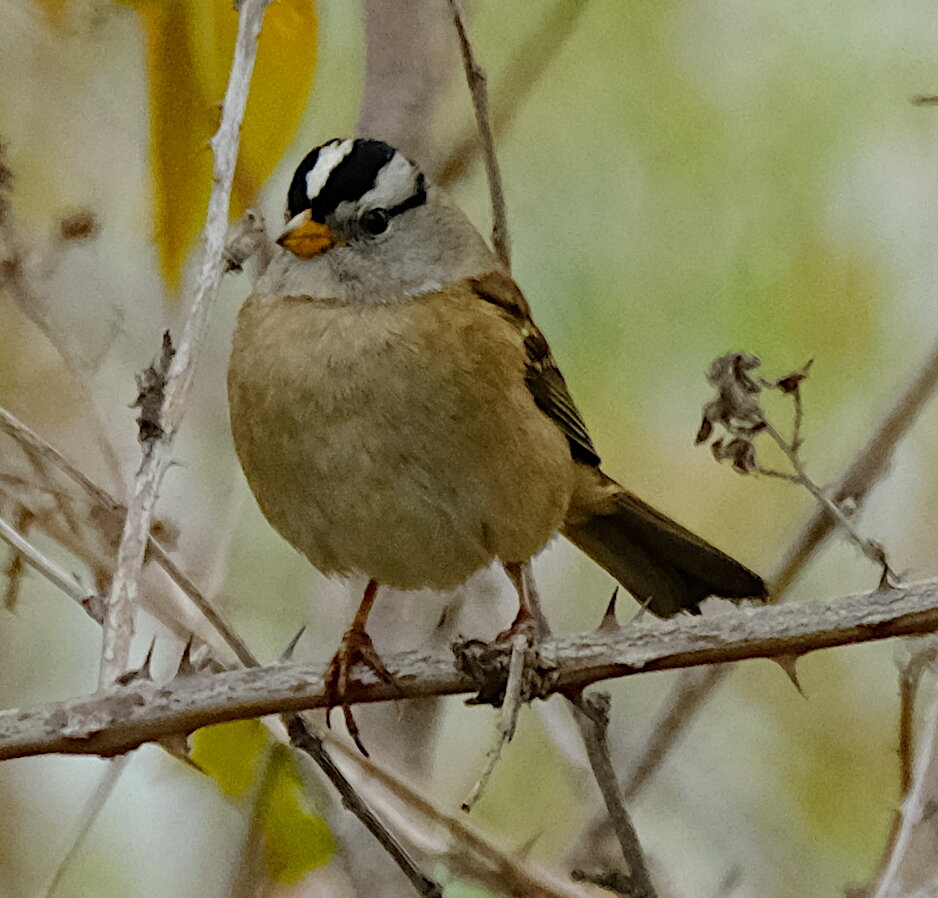White-crowned and Golden-crowned Sparrow
by Dave Zittin
In the fall many migrant bird species leave northern areas and head south to the relatively mild winters of California. Two such species are affectionately referred to as “crowned sparrows”. Adults of both of these species have distinct crown markings which we can use to tell them apart. Both species began returning to Santa Clara County in the past few weeks and are now abundant throughout much of the county. They will remain here until late spring.
Attracting them to backyards
Crowned sparrows love backyards, especially if seed is placed on the ground or on platform feeders and they will eat almost any commercial bird seed mixture. They are opportunistic feeders that will also eat fruits, vegetables, insects and spiders and will ravage emerging garden seedlings. If you have a veggie garden you will want to place a protective covering over the seedlings. I used to lay chicken wire over seedlings to protect them until they were large enough to escape foraging birds.
Description
White-crowned and Golden-crowned Sparrows belong to a small genus of sparrows, Zonotrichia, whose adults have distinct crown patterns and a brown back with black striping. Both of these species have an unmarked, uniform tan-gray breast color. The two species are easily told apart from each other as adults. The adult White-crowned Sparrow has distinct white and black stripes stripes on its crown (the top of the head). The adult Golden-crowned Sparrow has a distinct black crown that is divided at the top of its head, with a golden-colored central area.
Adult White-crowned Sparrow with distinct white and black stripes stripes on its crown. Photo: Dave Zittin
Adult Golden-crowned Sparrow with distinct black crown divided by a golden-colored central area. Photo: Dave Zittin
Telling immature individuals apart is often a challenge for beginning birders, but it's really not difficult. The two species have different beak colors regardless of age. The immature White-crowned Sparrow's bill is mostly a bright yellow or yellow-orange color and if there is any dark color on the bill it is found only as a small spot at the tip of the bill. The Golden-crowned Sparrow has a bill that is a uniform dusky gray color along its entire length and the upper beak is darker than the lower beak.The face patterns of the immature birds also differ. The White-crowned Sparrow's head is boldly striped with brown and creamy buff stripes. Striping is less apparent on Golden-crowned Sparrow's face and there is a small yellow patch on the top of the crown.
Immature White-crowned Sparrow. Photo: Carter Gasiorowski
Immature Golden-crowned Sparrow. Photo: Brooke Miller
Distribution
Both species start their northern migration to breeding grounds, leaving Santa Clara County by the end of April and return to winter here starting in September.
The Golden-crowned Sparrow's distribution is restricted to the westernmost parts of the continental United States, Alaska and Canada. In the winter this species occurs over the west coast of the continental United States. In the summer they range from Western British Columbia north along the coast, SE Alaska and north to cover much of western Alaska. The Golden-crowned Sparrow was a nemesis bird for the gold miners of the 1800s who likened its song to: “I'm so tired” or “No gold here”. “Oh dear me” is another interpretation.
The White-crowned Sparrow has a much wider distribution. In the winter it occurs across much of the southern half of the United States and south into northern Mexico. In the summer breeding season it occurs in the Northern Rocky Mountains, north into Alaska and across Northern Canada all the way to Labrador. There are some populations that do not migrate and an example close to us is on the coast at Half Moon Bay where they are found throughout the year.
Explore
Listen to songs of both species in All About Birds because both species sing outside of their breeding season.
All About Birds: White-crowned Sparrow
All About Birds: Golden-crowned Sparrow
More Backyard Bird Information
View more common Santa Clara County Backyard Birds
Visit our Backyard Birding page
Read our Notes and Tips from a Backyard Birder series
Tell us what you’re seeing in your yard! Send your notes, photos, and sound clips to backyardbirds@scvas.org. We’ll feature your submittals on our website.
Banner Photo Credit: Golden-crowned Sparrow by Tom Grey





